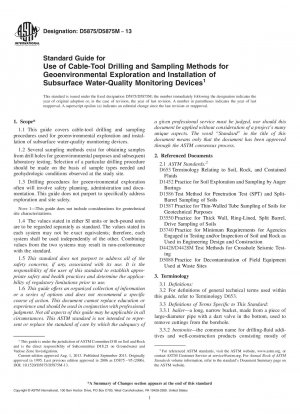ASTM D5875/D5875M-13
Standard Guide for Use of Cable-Tool Drilling and Sampling Methods for Geoenvironmental Exploration and Installation of Subsurface Water-Quality Monitoring Devices
- Standard No.
- ASTM D5875/D5875M-13
- Release Date
- 2013
- Published By
- American Society for Testing and Materials (ASTM)
- Status
- Replace By
- ASTM D5875/D5875M-18
- Latest
- ASTM D5875/D5875M-18
- Scope
4.1 Cable-tool rigs (also referred to as churn rigs, water-well drilling rigs, spudders, or percussion rigs) are used in the oil fields and in the water-well industry. The Chinese developed the percussion method some 4000 years ago.
4.2 Cable-tool drilling and sampling methods may be used in support of geoenvironmental exploration and for installation of subsurface water-quality monitoring devices in both unconsolidated and consolidated materials. Cable-tool drilling and sampling may be selected over other methods based on its advantages, some of which are its high mobility, low water use, low operating cost, and low maintenance. Cable-tool drilling is the most widely available casing-advancement method that is restricted to the drilling of unconsolidated materials and softer rocks.
4.2.1 The application of cable-tool drilling and sampling to geoenvironmental exploration may involve sampling unconsolidated materials. Depth of drill holes may exceed 900 m [3000 ft] and may be limited by the length of cable attached to the bull reel. However, most drill holes for geoenvironmental exploration rarely are required to go that deep. Rates for cable-tool drilling and sampling can vary from a general average of as much as 7.5 to 9 m/h [25 to 30 ft/h] including setting 200 mm [8 in.] diameter casing to considerably less than that depending on the type(s) of material drilled, and the type and condition of the equipment and rig used.
Note 2—As a general rule, cable-tool rigs are used to sample the surficial materials, and to set surface casing in order that rotary-core rigs subsequently may be set up on the drill hole to core drill hard rock if coring is required.Note 3—The quality of the result produced by this standard is dependent on the competence of the personnel performing it, and the suitability of the equipment and facilities used. Agencies that meet the criteria of Practice D3740 are generally considered capable of competent and objective testing/sampling/inspection/etc. Users of this standard are cautioned that compliance with Practice D3740 does not in itself assure reliable results. Reliable results depend on many factors; Practice D3740 provides a means of evaluating some of those factors.4.2.2 The cable-tool rig may be used to facilitate the installation of a subsurface water-quality monitoring device(s) including in-situ testing devices. The monitoring device(s) may be installed through the casing as the casing is removed from the borehole. The sand line can be used to raise, lower, or set in-situ testing device(s), or all of these. If necessary, the casing may also be left in the borehole as part of the device.
Note 4—The user may install a monitoring device within the same borehole wherein sampling, in-situ, or pore-fluid testing, or coring was performed.1.1 This guide covers cable-tool drilling and sampling procedures used for geoenvironmental exploration and installation of subsurface water-quality monitoring devices.
1.2 Several sampling methods exist for obtaining samples from drill holes for geoenvironmental purposes and subsequent laboratory testing. Selection of a particular drilling procedure should be made on the basis of sample types needed and geohydrologic conditions observed......
ASTM D5875/D5875M-13 Referenced Document
- ASTM D1452 Standard Practice for Soil Investigation and Sampling by Auger Borings
- ASTM D1586 Standard Test Method for Penetration Test and Split-Barrel Sampling of Soils
- ASTM D1587 Standard Practice for Thin-Walled Tube Sampling of Soils for Geotechnical Purposes*, 2024-04-21 Update
- ASTM D3550 Standard Practice for Thick Wall, Ring-Lined, Split Barrel, Drive Sampling of Soils
- ASTM D3740 Standard Practice for Minimum Requirements for Agencies Engaged in the Testing and/or Inspection of Soil and Rock as Used in Engineering Design and Construction
- ASTM D4428/D4428M Standard Test Methods for Crosshole Seismic Testing*, 2024-04-21 Update
- ASTM D5088 Standard Practice for Decontamination of Field Equipment Used at Nonradioactive Waste Sites
- ASTM D653 Standard Terminology Relating to Soil, Rock, and Contained Fluids
ASTM D5875/D5875M-13 history
- 2018 ASTM D5875/D5875M-18 Standard Guide for Use of Cable-Tool Drilling and Sampling Methods for Geoenvironmental Exploration and Installation of Subsurface Water Quality Monitoring Devices
- 2013 ASTM D5875/D5875M-13 Standard Guide for Use of Cable-Tool Drilling and Sampling Methods for Geoenvironmental Exploration and Installation of Subsurface Water-Quality Monitoring Devices
- 1995 ASTM D5875-95(2006) Standard Guide for Use of Cable-Tool Drilling and Sampling Methods for Geoenvironmental Exploration and Installation of Subsurface Water-Quality Monitoring Devices
- 1995 ASTM D5875-95(2000) Standard Guide for Use of Cable-Tool Drilling and Sampling Methods for Geoenvironmental Exploration and Installation of Subsurface Water-Quality Monitoring Devices

Copyright ©2024 All Rights Reserved